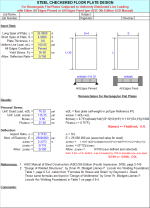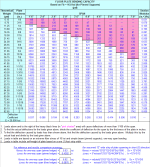FLRPLATE.xls

Description
"FLRPLATE" is a spreadsheet program written in MS-Excel for the purpose of designing steel checkered floor
plate subjected to uniformly distributed loading.
This program is a workbook consisting of two (2) worksheets, described as follows:
- Doc - Documentation sheet
- Steel Floor Plate Design - Steel checkered floor plate design for uniformly distributed loading
All the worksheets are independent and self contained, so that you can move them from one workbook to another. All the worksheets are protected, but not with a password.
Program Assumptions and Limitations:
1. This program utilizes the formulas given in "Design of Welded Structures" by Omer W. Blodgett (James F. Lincoln Arc Welding Foundation) in Table 1 on page 6.5-4. The formulas therein were taken from "Formulas for Stress and Strain", by Raymond J. Roark, for rectangular flat plates subjected to uniform pressure. These same formulas are found in "Design of Weldments" by Omer W. Blodgett (James F. Lincoln Arc Welding Foundation) in Table 1 on page 4.6-4 as well.
2. This program follows the procedures and guidelines of the AISC 9th Edition Allowable Stress (ASD) Manual, (Fourth Impression 9/00), and the "Floor Plate Bending Capacity" Table found on page 2-145 is replicated off of the main calculation worksheet at the right side of the screen. Also, at the right side of the screen, there are two (2) additional allowable uniform loading tables, one based on flexural strength and the other based on deflection criteria. Both of these tables consider the user input value of the plate yield stress, 'Fy'.
3. If the user desires to simulate true one-way span action for the plate analysis and design, then a value of the plate long span, 'L', which is input should be at least 8 times the value of the plate short span, 'S'.
Calculation Reference
AISC Steel Construction Manual
Calculation Preview
Full download access to any calculation is available to users with a paid or awarded subscription (XLC Pro).
Subscriptions are free to contributors to the site, alternatively they can be purchased.
Click here for information on subscriptions.
Several people had asked about why the allowable bending stress, Fb, was limited to 16 ksi in the Floor Plate Bending Capacity table in the AISC Manual. The answer is best explained in the article "Are You Properly Specifying Materials?" by Charlie J. Carter, S.E., P.E. from "Modern Steel Construction" magazine, January 2004 (as follows):
Raised-Pattern Floor Plates
ASTM A786 is the standard specification for rolled steel floor plates. As floor plate design is seldom controlled by strength considerations, ASTM A786 "Commercial Grade" commonly is specified. If so, per ASTM A786 Section 5.1.2, "the product will be supplied 0.33 percent maximum carbon and without specific mechanical properties". Alternatively, if a defined strength level is desired, ASTM A786 raised-pattern floor plate can be ordered to a defined plate specification, such as ASTM A36, A572, or A588; see ASTM A786 Sections 8 and Appendix Table X1.1.
In order for the worksheet to be able to create a calculation which would reflect the values in the AISC Manual table, I added the user input asking if the allowable bending stress is to be limited to 16 ksi or not. I also added a couple of comment boxes as well as a couple of visible notes on the calculation page pertaining to simulating one-way action and plate yield stress.
This workbook is now version 1.6.
Thanks for all your contributions.
Now, if you have a true 2-way designed plate, it probably would be good to limit the deflection to about 1/2 of the plate thickness for the 2-way formulas to me more valid. Of note, some floor plate vendors merely show 1/4" as a deflection criteria in their catalogs. Maybe the logic there is simply that most applications rarely call for floor plate thicknesses greater than 1/2".
I try to avoid interjecting my own opinions or judgements on design criteria in my spreadsheets, because I would never get agreement from everyone that uses them. But on the other hand, I really can't keep people from abusing or misusing them either. Engineering experience and judgement must come into play. Remember, I'm not a teacher and I'm certainly not trying to teach any of you anything. My spreadsheets are merely tools to help facilitate our day to day work.
I'll ponder over your comments and then decide what to add to the spreadsheet.....maybe some sort of advisory note or something like that.
Alex
Roark also assumes that the thickness is not more than about one quarter of the least transverse dimension, and the maximum deflection is not more than about one-half the thickness; I guess that's why God invented large deflection non-linear finite element analysis?
Great spreadsheet! I've used it many times. Thank you, thank you! Recently, I had the case of 16ga sheet metal spanning 34" x 17". This spreadsheet is bounded at 1/8" on the lower end of thickness, so I had to open Roark and Young (5th ed), where I found something interesting. At the beginning of Ch.10, "Flat Plates", one of the assumptions is ". . . maximum deflection is not more than about one-half the thickness." Perhaps that is the boundary between beam action and catenary action. Anyway, from here forward I'll use 0.5t as a deflection limit.
John Doyle: Does this automatically get sent to Alex?
Thanks for your great site!!
Recently, I had the case of 16ga sheet metal spanning 34" x 17". This spreadsheet is bounded at 1/8" on the lower end of thickness, so I had to open Roark and Young (5th ed), where I found something interesting. At the beginning of Ch.10, "Flat Plates", one of the assumptions is ". . . maximum deflection is not more than about one-half the thickness." Perhaps that is the boundary between beam action and catenary action.
Anyway, from here forward I'll use 0.5t as a deflection limit.



